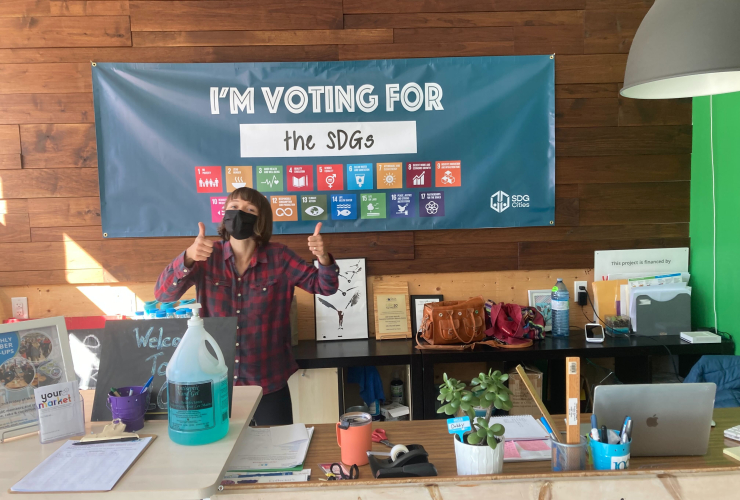“New things are really hard to do in the Government of Canada.”
— Hon. Karina Gould, speaking in her former role as minister of families, children and social development
With a polycrisis threatening humanity’s future, governing for the common good is becoming exceedingly difficult. The issues are complex, the stakes are high, and civic institutions in health care, education, justice — even our democracy — are under stress. As the exodus of nurses from hospitals, teachers from schools and women from politics indicates, for a growing number of people working in these institutions, conditions are becoming unbearable.
Amid the sounding of alarm bells on climate change and a stream of other shocks to our collective and individual well-being, our greatest risk is that we ignore the essential work of re-engineering society before it is too late. Instead of quick fixes, technological fantasies and hollow promises that waste precious time, money and public trust, we need to collectively commit to building a regenerative economy — one that restores and rejuvenates natural resources, social systems and communities — where everyone enjoys a level of sufficiency and the commons flourishes.
This work begins with critically examining the systems that have brought us to this state of precarity, acknowledging our complicity in sustaining the status quo and our responsibility to work on transforming it. It entails imagining and testing alternatives and requires civic engagement and polycentric governance — where multiple centres of power and authority interact to address complex issues. By enabling diverse actors to contribute their unique strengths, it can enhance adaptive capacity, foster innovation and establish more inclusive decision-making.
It also requires finance for systems innovation.
In Good Economics for Hard Times, Nobel Prize-winning economists Abhijit V. Banerjee and Esther Duflo contend that to address intractable challenges, governments should finance experiments that generate evidence-based strategies for larger, systemic interventions. Without evidence, they argue, governments often resort to superficial fixes that ignore root causes or replicate unworkable “solutions” that achieve the opposite of what was intended — like building more pipelines instead of phasing out production altogether.
Another way governments sidestep responsibility is by outsourcing controversial or “stuck” files to consultants to reduce costs, accountability or political risk. Between 2015 and 2022, 10 federal ministries contracted McKinsey for $66 million in advisory services. While a recent audit found no evidence of political interference in this instance, governments continue to spend billions on outsourcing to IT firms, management consultants and temporary help contractors. Some of this may be justifiable but in the long run, it reduces public sector capacity while starving the community sector of financial resources and opportunities to collaborate on solution finding.
The Social Finance Fund (SFF) offers an alternative. The federal government launched the SFF on May 29, with $400 million of an eventual $755 million placed with three “wholesalers”. It will support the growth of Canada’s social economy, improve excluded and vulnerable groups’ access to capital for social enterprise startups and service innovation, and help to develop a market for outcomes funds that use blended finance.
Investing in social and environmental outcomes, as opposed to stocks or commodities, combines the strengths of the public, private and community sectors to turn complex problems into opportunities for inclusive growth and societal transformation.
“[The long-term impact of the Social Finance Fund should be that] when investors are looking to invest their money, they [will be] making decisions based on the outcomes that organizations are putting forward. [As a result,] there is going to be a lot more confidence in the market to say that we support organizations that have social, environmental outcomes as their objectives.”
— Minister Gould, op. cit.
Manitoba leads the country in the use of an outcomes finance tool called a social outcomes contract (SOC), or social impact bond (SIB).

After an Indigenous community solutions lab called The Winnipeg Boldness Project developed a prototype Indigenous doula initiative, the province and partners created a two-year, $3.5-million SIB that proved Indigenous doulas could reduce child apprehensions and improve outcomes for children and families, while lowering the cost to government.
Encouraged, the province established a Social Innovation Office (SIO), to tackle other complex challenges. Working with government ministries, community stakeholders and impact investors, SIO’s staff of data and financial analysts, program managers, evaluators and an anthropologist co-develop testable solutions to challenges like reducing youth involvement in the justice system, improving women’s heart health and lowering methane emissions in the agricultural sector.
Some initiatives became SIBs, with impact investors providing repayable capital to finance program testing and evaluation. In other cases, the government simply proceeds on the basis of the SIO’s analysis to change the systems involved.
The Indigo database at Oxford’s Government Outcomes Lab lists 280 SIBs and SOCs around the world. New variants are emerging, including Development Impact Bonds and Conservation Impact Bonds. The Canadian-based Peace Coalition is proposing a SIB finance a model for Ukraine’s reconstruction, while Raven Indigenous Capital Partners is developing a $50-million outcomes fund, half to be invested in Indigenous health outcomes and half in climate initiatives.
The Raven fund builds on past work using community-driven outcomes contracts to reduce the incidence of diabetes on reserves, and to replace diesel generators with geothermal energy systems in remote northern communities.
“Government policy is like an oil tanker, and we’re in the business of turning an oil tanker around. [Social outcomes contracts] are tugboats: they’re nimble and can change direction easily. It’s a labour-intensive process to shift the direction of an oil tanker, but it’s worth it. Once you’ve shifted the oil tanker, that’s a lot of power moving in a different direction.”
— Louise Savell, director, Social Finance
As a tool for building regenerative economies, outcomes funds and blended finance provide governments, social purpose organizations and impact investors with a means of aligning efforts around common purpose and bold goals, sharing the power to co-design and learn from interventions.
They establish new relationships among stakeholders, including vulnerable populations, and put new resources in the hands of communities.
The money is important, but co-designing inclusive processes and orchestrating multi-stakeholder commitments to learning and innovation make creating and administering SIBs and SOCs more valuable than money alone.
As Manitoba is doing with its Social Innovation Office, governments should engage policymakers, community stakeholders and impact investors in testing new approaches to stuck problems. Collaborating on regenerative economics and the infrastructure for socioeconomic transition increases the likelihood that society will safely and successfully navigate the coming decade.
Stephen Huddart is an adjunct professor at the University of Victoria’s Gustavson School of Business and advises several socioeconomic transition initiatives. He is a member of the National Observer’s advisory board.






Comments